Introducing the Dachshund
Discover all there is to know about the Dachshund: its characteristics, behavior, training, and its cost.
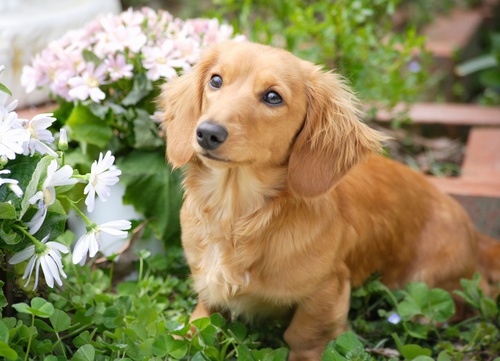
Discover all there is to know about the Dachshund: its characteristics, behavior, training, and its cost.

The Dachshund's origin is rooted in Germany, where it was primarily bred for hunting, especially burrow-dwelling animals like badgers. Their name, in fact, translates to "badger dog" in German. The elongated body and diminutive legs of the Dachshund are not just for show; they're the result of selective breeding to produce a dog agile enough to navigate burrows. This tiny dynamo has since become one of the most adored breeds worldwide.
Whether they're tracking scents, keeping their family's laps warm, or participating in mini dog races, the Dachshund is truly multifaceted. Above all, with their unwavering loyalty, the Dachshund showers an abundance of love and affection, making them a sociable companion that thrives in the company of their human counterparts.
This section presents the distinctive characteristics of the Dachshund breed.
The Dachshund belongs to the group of hunting dogs, group 4, known for its acute sense of smell and exceptional tracking abilities. Dogs in this group are often used for hunting, given their prowess at tracking scents.
The Dachshund, often referred to as a "wiener dog" due to its long body, is a small-sized breed. Typically, they stand about 5 to 9 inches at the shoulder and weigh between 16 to 32 pounds, depending on their subtype.
Dachshunds can have three types of coats: smooth, long-haired, or wire-haired. Each presents its own unique texture, from the sleekness of the smooth coat to the rough touch of the wire-haired variety.
Dachshunds exhibit a broad palette of coat colors. While the most iconic might be the reddish-brown, they can also be found in black, chocolate, blue, and fawn, often with tan or cream markings.
While Dachshunds are adaptable, they particularly thrive in homes with ample space to play and explore. However, due to their size, they can comfortably live in apartments if given regular exercise.
Dachshunds are spirited and bond closely with families, good with kids but wary of strangers. Their hunting instinct can make them cautious around other animals.
Dachshunds are robust for their size, but their elongated body can make them prone to back issues, particularly intervertebral disk disease. Regular check-ups and a good diet can help keep them healthy.
Dachshunds are intelligent and curious, which can sometimes be mistaken for stubbornness. While they're eager to please, consistent, kind, and patient training methods work best for this spirited breed.
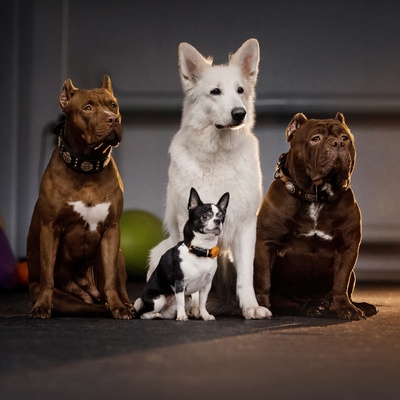
We can help!
Every dog has its own character, and so do you. Making the right choice will ensure his well-being and yours.
Take our quiz to find out which breed is right for you, based on your personality, lifestyle, location and many other criteria.
Don't wait any longer and take the quiz to find out the answer!
The Dachshund, with its signature long body, is a petite yet striking breed. Flaunting a coat that ranges from smooth to wiry, their expressive eyes and sharp snout give them an undeniably unique charm.
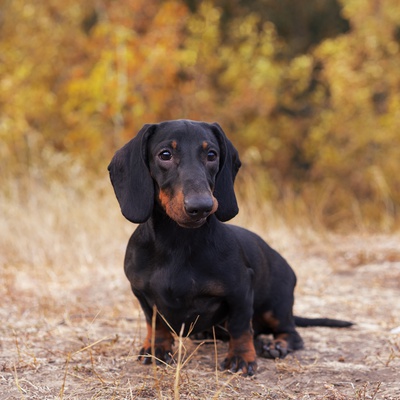
Dachshunds are quite small but vary based on their specific subtype. Typically, female Dachshunds stand between 5 to 8 inches, while males are around 6 to 9 inches.
In terms of weight, females typically weigh between 14 and 28 pounds, and males can weigh anywhere from 16 to 32 pounds.
Dachshund puppies experience a consistent growth pace. Within their first few months, they might weigh around 5 to 12 pounds. By the age of a year, most Dachshunds approach their adult size, although they usually reach their full maturity in terms of weight by the age of 18 months.

The Dachshund offers a variety of coat types that cater to diverse preferences. Generally, the breed can have smooth, long-haired, or wire-haired coats. The smooth coat is short and sleek, while the long-haired variant is soft and slightly wavy with some feathering, especially on the underbelly and ears. The wire-haired Dachshunds sport a coarse, dense coat with a prominent beard and eyebrows.
Dachshunds have a broad color palette that varies significantly within the breed. Common coat colors include solid shades like red, cream, and black, but many have two-colored combinations like black and tan, chocolate and tan, or even blue and tan. Some Dachshunds also feature dapple patterns, adding a playful mix to their overall appearance.

Dachshunds have three distinct coat types, each needing different grooming. Smooth-coated ones shed minimally and need occasional brushing for shine. Long-haired ones require weekly grooming to prevent matting, especially during shedding seasons. Wire-haired types, with a double coat, shed moderately and need regular brushing and occasional baths to remove dirt.
Despite their varied needs, Dachshunds are generally low-maintenance, but tailored care keeps them comfortable and tidy.

The Dachshund, often dubbed the "wiener dog" due to its distinct silhouette, is a balanced and well-proportioned breed. Its elongated head is tapered and features a slightly arched forehead, giving it an alert expression. The Dachshund’s almond-shaped eyes come in various shades of brown, depending on the coat color, and they often gleam with intelligence and curiosity. Its moderately long ears hang close to the head, positioned near the top. As for its body, it is notably elongated but robust, revealing a surprisingly strong musculature beneath its petite size.
Dachshunds are known for their bold and vivacious personalities. They're fiercely loyal, often playful, and carry an innate sense of curiosity.

In the diverse world of canines, there are over 400 distinct breeds categorized into 10 groups, each grouping breeds with similar attributes. The Dachshund falls into group 4, which is dedicated to Dachshunds alone, given their unique set of characteristics.
Historically bred for hunting, the Dachshund, or 'badger dog' in German, was tailored to burrow into dens and confront its quarry. This hunting lineage has imparted them with a keen sense of smell, intelligence, and an undeterred spirit. These attributes mean that while they might be small, they are brave and can sometimes display a stubborn streak. Their primary role, historically, was to hunt small game like rabbits and badgers, but today they are cherished more for their companionship and endearing nature.

Dachshunds are spirited and vivacious creatures. Their strong bond with their owners is evident in the affection and loyalty they display. Often eager to be at their owner's side, these little canines are filled with boundless love and warmth.
The Dachshund thrives in the presence of an attentive owner, and their emotional well-being is deeply tied to the time and care they receive. Leaving them alone for extended periods may lead to feelings of neglect and can manifest as destructive behaviors.
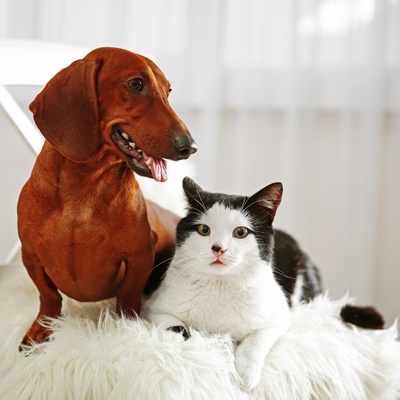
Despite their compact stature, Dachshunds are generous with their affection and have a heart that encompasses everyone they meet. They're sociable canines who generally fare well with both adults and children, making them an ideal family pet. Moreover, their interactions with kids often showcase their gentle and patient side.
However, due to their small size and sometimes stubborn nature, it's essential to teach children how to handle and play with them appropriately. While Dachshunds are naturally affable, it's crucial to socialize them from a young age to further ensure their comfort around various people and situations.
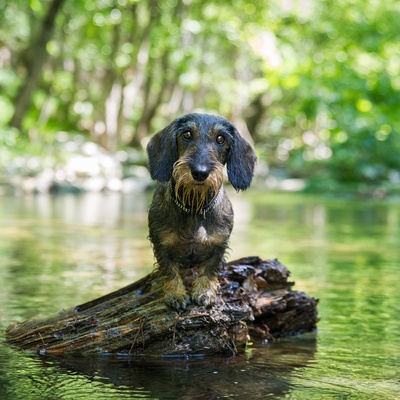
The Dachshund's petite size makes it an adaptable companion for various living situations, whether it be a cozy apartment in the heart of the city or a spacious home in the countryside.
However, despite their small stature, their vivacity cannot be underestimated. Owners must be diligent in providing them with ample attention and engaging activities. It is recommended that these spirited dogs be taken for at least two walks a day, with each lasting around 20 to 30 minutes to cater to their energetic nature.

Dachshunds are innately curious creatures with a robust hunting background. Their inquisitive nature makes it essential for them to have access to an outdoor environment where they can sniff, explore, and indulge their hunting instincts, albeit in a more playful manner.
Whether it's a garden, a park, or a secured outdoor space, allowing them to exercise their curiosity helps keep them mentally stimulated and physically fit. However, owners should always supervise their excursions to ensure their safety, given their penchant for digging and chasing.
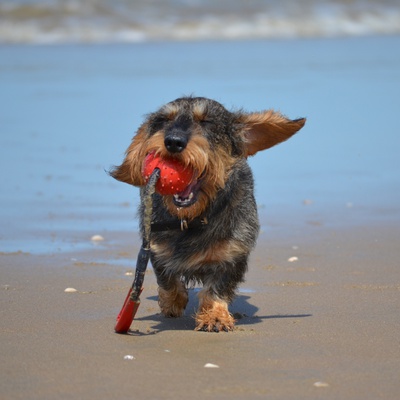
While the Dachshund might be small in size, its intellect is undeniably vast. This breed possesses an astute mind and is typically eager to learn.
Training a Dachshund, however, comes with its unique nuances. Stemming from their hunting heritage, they can sometimes exhibit stubbornness and independent thinking. Hence, consistency and positive reinforcement methods work best with them. Despite their intelligence, they can be prone to distractions given their curious nature. For this reason, equipping them with a GPS collar can be a wise precaution to prevent potential losses or adventurous escapades.
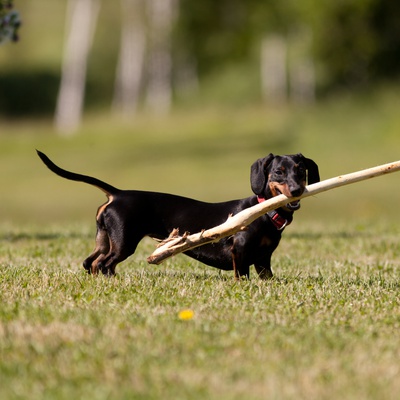
When it comes to listening skills, Dachshunds can be quite impressive. They have an innate ability to understand commands when delivered with clarity and consistency. Yet, it's essential to remember that their strong-willed character can sometimes overshadow their listening prowess.
As a result, patience is vital during training sessions. Introducing varied training exercises can keep them engaged and prevent monotony. With the right approach, the Dachshund can be trained to perform an array of tasks, showcasing not just their intelligence but also their versatile nature.
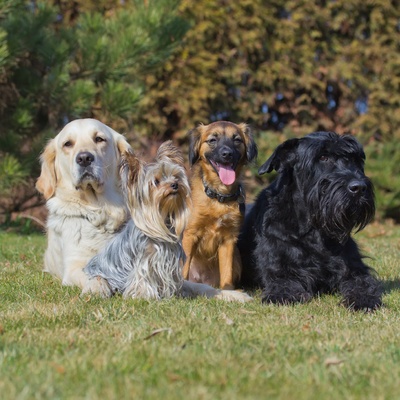
Take the test and find out the dog breed that matches your personality and lifestyle.
Known for its unique shape and lively spirit, the Dachshund is mostly healthy. However, regular care is vital due to its distinct physique to prevent potential ailments.

Dachshunds, in general, exhibit good overall health. However, their elongated spine makes them susceptible to back issues, particularly Intervertebral Disc Disease (IVDD). This condition can lead to pain, partial, or even complete paralysis. Being aware of this predisposition, owners should take precautions to ensure their Dachshunds avoid jumping off high places or straining their backs. Additionally, they can be prone to dental issues given their small mouths, so regular dental check-ups are beneficial. Obesity can exacerbate the strain on their spine, so monitoring their weight is crucial.
Dachshunds typically have a lifespan ranging from 12 to 16 years, given proper care and attention.
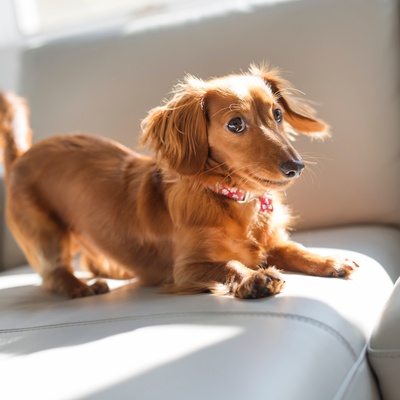
Regular veterinary visits play a pivotal role in ensuring the well-being of a Dachshund. These check-ups will ensure they're up-to-date with vaccinations, deworming, and are given timely treatments against parasites.
In addition to these medical routines, at-home care is equally important. Brushing the coat, depending on its type (short-haired, long-haired, or wire-haired), is essential to keep it sleek and free from matting. Due to their predisposition to dental issues, their teeth should be cleaned regularly to avert tartar build-up. Cleaning their ears is a crucial routine to prevent possible infections, and it's advised to trim their nails regularly for comfort and mobility.
Dachshunds may react to some foods, so monitor their diet and consult a vet before major dietary changes. They're not hypoallergenic.

Dachshunds have unique nutritional needs due to their physique and energy. A balanced diet with quality kibble is vital. If active, they can benefit from lean meats, but watch fat intake as they're prone to obesity, which stresses their spines.
Despite their enthusiasm for food, proper portion control is crucial for their health.
The Dachshund is a beloved breed with a unique shape and lively spirit. Many breeders specialize in them, but careful consideration is vital before adopting.

Embarking on the journey to adopt a Dachshund requires careful thought and consideration. A crucial first step is to ensure that the breeder is reputable. Pay a visit to the breeder's facility to observe the living conditions of the dogs and gauge their behavior, as these are telltale signs of the breeder's commitment to the animals' welfare.
Furthermore, prioritize the health of the puppy you wish to adopt. It's essential to glean transparent information from the breeder regarding the puppy's current health status and any illnesses that might exist in its lineage.
Lastly, mandatory electronic identification, like microchipping, is not always mandated at the federal level in the United States for cats and dogs. But microchipping is widely acknowledged as a successful way to permanently identify pets and increase the possibility of reuniting lost pets with their owners, even in the absence of universal regulations. As a pet owner, it is advised to inform yourself about municipal laws to ensure the safety and wellbeing of your pet.
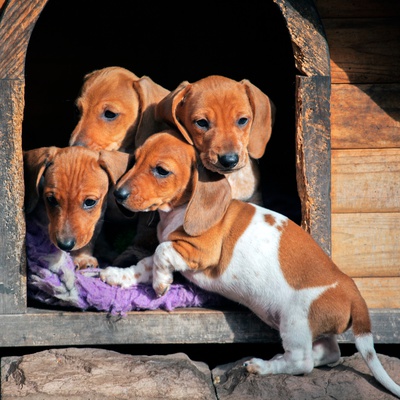
When it comes to the acquisition cost of a Dachshund, prices can span a broad range, influenced by factors like lineage, pedigree, the breeder's reputation, and the age of the dog. Currently, Dachshund puppies can cost anywhere between
$ 660
to
$ 2200
when bought from breeders.
However, the initial cost is just the beginning. Owning a Dachshund carries with it ongoing expenses for items such as food, vet visits, grooming, and other essentials. Annual maintenance costs for a Dachshund typically range from
$ 1400
to
$ 1 650
.